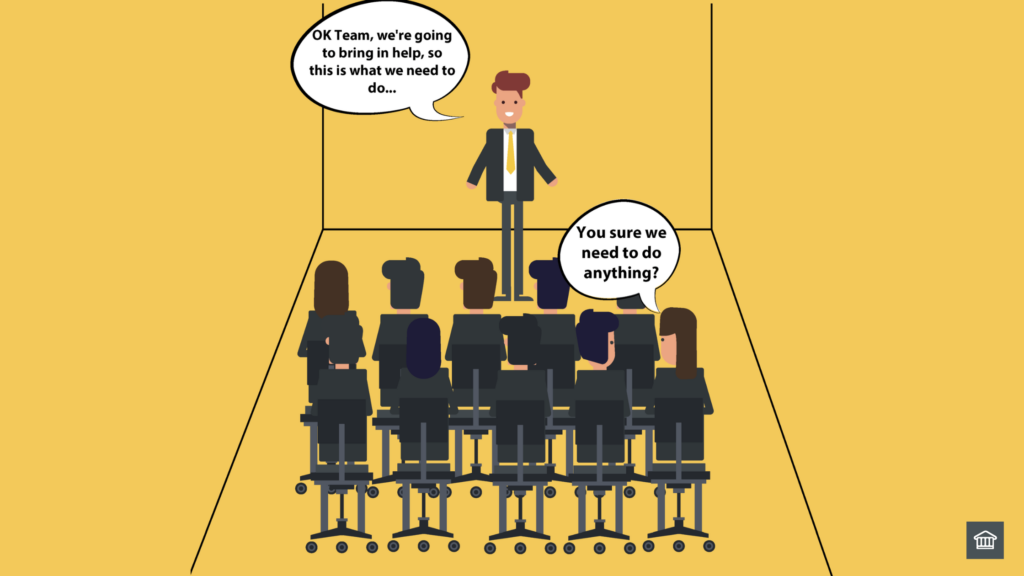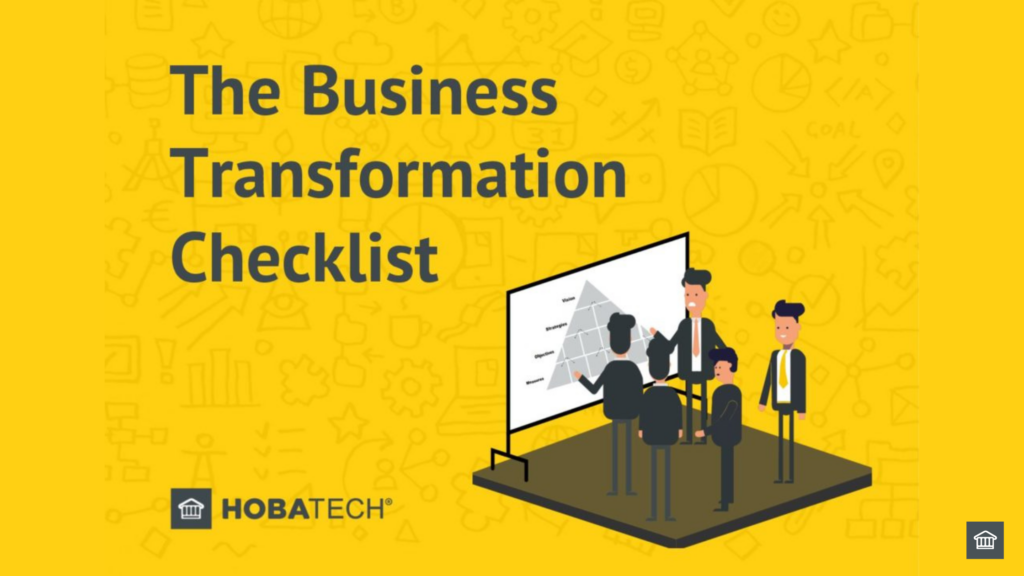In this part 2 (of 3 parts) post, we discuss whether a company should hire a professional consultant or manage their business transformation internally?
In part 1 we addressed the questions that a company has when they are deciding whether they go it alone, or bring in hired help. If you missed it, check it out here.
In this second part, if you are a Company and decided to hire a professional consultant to help you with your business transformation instead of do it internally, then this article is for you.
If this is the case, then as part of that decision making process, you have also understand what is required on your behalf.
There is a few mistakes Companies make when hiring a consultant or consultancy to manage their business transformation. Here is the top four (4) mistakes and how to avoid them
(click the links to skip to the section below):
NB: Click the images to expand them 📸
1. They want it done for you.
News flash! Sorry, ‘done-for-you’ that doesn’t exist, if it does, it doesn’t work (you probably wont hear that from too many others!).
You (the Company) need to be involved. The Consultant doesn’t know your business best.
The best Academic who wrote 10-books on the theory about your industry doesn’t know your business best. Your staff do. Your staff know your business best. It’s the Consultants job to get the answers out of them (how they do that, we will cover shortly).
You need to be available to answer those questions, make time available to consider them and most of all, have the capacity to challenge the findings that come from questions.
What you actually want is ‘done-with-you’, where as the Client, you provide the answers to the Consultants questions.

6-Steps to Business Transformation Success
WHAT THE TOP 30% OF ORGANISATIONS KNOW THAT YOU DON’T 👉

👏 "The No.1 Mistake Companies make when they hire a consultant to manage their business transformation, is they want it 'done for you'. Sorry, that doesn't exist, if it does, it doesn't work. 'Done-with-you' is the answer" 🔐😱 #BusinessTransformation #RedFlags #BusinessTransformationFailure #HOBA
Heath Gascoigne Tweet
2. They don't trust the process
The no. 1 reason why consultants and consultancies are hired is because of their high degree of expertise and knowledge.
You bring the consultant in so they can tell you want to do. Steve Jobs has a famous quote around this:
“It doesn’t make sense to hire smart people and then tell them what to do. We hire smart people so they can tell us what to do.” – Steve Jobs

If you are bringing in a consultant to run your business transformation for you, let’s assume it’s the first time you have done a Business Transformation, or the first time that your business required transforming.
If it’s the first time, then you have to trust the process. Directors, Managers and Staff are good at running the business, not necessarily good at changing it.
This ‘change’ that they you/they will go through may look and feel different (let’s be clear – ‘different’ is not ‘right’ or ‘wrong’, just different).
You will be asked to look at the Business differently, as opposed to how you look at it, from the inside-out, now you will be asked to look at it from the outside-in.
Sometimes we are all too close to the problem, that what we need is a fresh perspective, and to step back, to assess the situation, to see:
- What is working (keep doing),
- What is not working (stop doing) and
- What you are not doing (start doing).
But to do that, you have to trust the process.
Of course, in order to trust you the process, you first have to understand the process.
Need a process? Have a look here to see the process that is now used and trusted by thousands around the world to transform their Organisations.
When your Consultant or Consultancy present their approach and process how they will manage your business transformation, you have to trust it.
But here’s the caveat, before you just blindly trust their process:
- If it sounds complicated, it probably is.
- If it sounds like marketing spiel, it probably is too.
Note – These are the latest “marketing terms”, that are pitched as the silver bullet, but actually, they are marketing fluff, also known as (aka):
- Co-create (aka work together)
- Ide-ation (aka brainstorming)
- Design thinking (aka problem solving)
- Innovation (aka the act or process of creating something new idea)
- Human centric (aka we’re going to ask customers what they think)
- If you can’t understand it, there’s a good chance you don’t.
Business Transformation is not a complicated process, despite what you may have been told. It’s actually a simple process, and it has 6-steps. If you’re not familiar with the 6-Step Design Process, download our FREE 6-Steps to Business Transformation eBook here.
3. They’re not you willing to put in the work?
Depending on your school of thought (e.g. waterfall, agile, wa-gile, water-scrum-fall?), your chosen Consultant or Consultancy is going to work through a process to help and manage your business transformation.
That process will involve some steps or stages. For example:
- Discovery (understand what the problem is);
- Design (design a solution – people, process, technology and data, to address those problems), and
- Delivery (build, test and implement) those changes.
At each step or phase along the way, the Company (the Client) needs to be involved in the process, to provide input.
These people that the Company (the Client) sends to those meetings needs to be prepared to do the work. That means respond to the meeting requests, read the request, understand what is asked or required, turn up to those meetings and contribute.
If they can’t make it, or are not best suited, they need to put their hand up and say so.
Heres the mistake: Time and again I have seen the Client sends the ‘wrong’ people or person, they don’t have the suitable or relevant knowledge, experience in their position or organisation nor the right level of management oversight nor authority to actually make those decisions or have those decisions supported.
What happens is they contribute to the work to the best of their ability, it is signed off, but “Others” question Who? was involved in forming those decisions, those decisions end up being ‘unpicked’, and the whole process is effectively nullified.
The Result: a waste of everyone’s time, effort and money.
The Answer: when agreeing the Governance Model – the framework of how you will manage decisions, scope, risks, issues, dependencies and issues, which naturally includes the RACI (Responsible, Accountable, Consulted, Informed), make sure you have the right people on it, and most importantly – there is no contention about membership to it.
Need a checklist to make sure you got all the critical boxes ticked for your Business Transformation? Check out this checklist (direct download, no opt in) here.
👏 "The 3rd biggest mistake Companies make is nominating the wrong people on the RACI, "Others" question Who? was involved in forming those decisions, those decisions end up being ‘unpicked’, and the whole process is effectively nullified. The result: a waste of everyone’s time, effort and money" 🔐😱 #BusinessTransformation #RedFlags #BusinessTransformationFailure #HOBA
Heath Gascoigne Tweet
4. They are not willing to take action
It’s one thing to acknowledge the invites, attend the meetings, show up and contribute your input. That’s the easy part. The hard part is change.
The problem: People are creators of habit.
Even when the change is in their benefit. People will resist the change.
The number of times I have seen, with Clients and transformations I have been involved in, or called into help is after all the work is done and agreed – through all the phases from discovery, design and just before delivery, the Founder, MD or Executive team member(s) will say:
“I like it, but not for my team”,
or
“I like it, but I’m not going to do it”.
And when pressed as to “Why, why not (i.e. implement the changes they agreed too)?”, the number 1 answer is “You’re changing the company” or “this is not the direction I/we want to take the company”.
The Answer: And that’s why when we come on the job (after agreeing the Approach), the first thing we do is to agree the Vision (the Why?) – this is the number 1 requirement for the transformation. All requirements, stakeholder wants and needs, and most importantly, all activity on the project and programme, needs to trace from it, and back to it i.e. it needs to support it. If it doesn’t you have to ask why that requirement is in scope, and/or why you are spending any time discussing it.
Agreeing the Vision isn’t just agreeing a 25,000 foot Vision Statement, that Vision Statement needs to be articulated and decomposed down (and agreed) into its contributing parts:
- Strategy (the How?),
- Objectives (the What?), and
- Measures (the When?).
The reason you decompose the Vision into its subsequent parts, is so between us and the Company (the Client), we are ALL very clear what the future looks like, and the “direction we are taking it” (the Vision!), so we avoid this happening.
Looking for an easy to follow, easy to understand and therefore easy to implement approach, download our FREE Six Steps to Business Transformation Success eBook here.
Looking for the Best Training to deliver your Business Transformation? Search no more!
- 30-Day Money-Back Guarantee
- Risk FREE

👏 "The 3rd biggest mistake Companies make with their transformation is they themselves are not willing to take action. It is 'done-with-you' not 'done-for-you' (unless you want to Consultancy to never leave because you never learned" 🔐😱 #BusinessTransformation #RedFlags #BusinessTransformationFailure #HOBA
Heath Gascoigne Tweet
Conclusion
The Top 4 mistakes a company makes when they hire a professional consultant, independent contractor or consultancy to manage their business transformation are:
- They want it done for you
- They don’t trust the process
- They are not willing to put in the work
- They are not willing to take action
Stay tuned for part 3, when we discuss ‘now you have made that decision, what’s to expect of the Consultant’.
If you want help with your business transformation, you can reach out via this form to work with a professional consultant.
If you want 1-on-1 coaching, to help you through your business transformation, see our coaching here.
If you have any more questions, view our frequently asked questions (FAQs) section here.
Thank you for reading this!
Sincerely,

Heath Gascoigne
P.S. If you want to join our Business Transformator community of like-minded Business Transformators, join the community on the Business Transformator Facebook Group here.
P.P.S. If you want to learn more about business transformation, check out The Business Transformation Playbook here.
For more information, visit https://www.hoba.tech

6-Steps to Business Transformation Success
WHAT THE TOP 30% OF ORGANISATIONS KNOW THAT YOU DON’T 👉
















